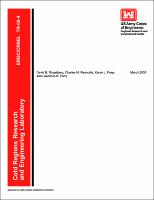Please use this identifier to cite or link to this item:
https://hdl.handle.net/11681/5389| Title: | Microbial community shifts associated with RDX loss in a saturated and well-drained surface soil |
| Authors: | Ringelberg, David B. Reynolds, Charles M. (Charles Michael), 1950- Foley, Karen L. Perry, Lawrence B. |
| Keywords: | Microorganisms Soil moisture Explosives |
| Publisher: | Cold Regions Research and Engineering Laboratory (U.S.) Engineer Research and Development Center (U.S.) |
| Series/Report no.: | ERDC/CRREL ; TR-05-4 |
| Abstract: | Low-order, incomplete detonations can deposit hexahydro-1,3,5- trinitro-1,3,5-triazine (RDX) into training range surface soils. In previous work, we showed that aqueous RDX could be rapidly biotransformed (4-day half-life) in water-saturated surface soil. However, biotransformation rates in the same soil at 0.15-bar soil moisture tension were significantly slower (28-day half-life). Here we report on the microbial community composition associated with the deposited RDX under the differing soil moisture tensions. Phospholipid fatty acid (PLFA) and terminal fragment length polymorphism (T-RFLP) profiles were used to quantify the in situ microbiota. The rapid biotransformation of RDX in the saturated soil was coincident with an endpoint microbial community containing firmicutes (36%), proteobacteria (54%), actinobacteria (8%), and bacteroidetes (1%). The unsaturated soil contained a greater number of genera (2.5 times that of the saturated soil) within similar phyla (19% firmicutes, 66% proteobacteria, 6% actinobacteria, 2% bacteroidetes, and 7% chlorobi). Significant differences between the two moisture contents occurred within the proteobacteria and firmicutes. A 37% gamma-class in unsaturated soil shifted to 56% alpha- and delta-classes in saturated soil. Total firmicutes increased from 19% unsaturated to 36% saturated. PLFA profiles extracted from saturated soil showed an increase in the relative abundance of only a few fatty acids (n16:0, n18:0, i15:0, a15:0, b16:1w7c, n18:1w9c, n18:1w7c, and cy19:0). However, these PLFAs are consistent with Gram-negative proteobacteria (n16:1w7c, n18:1w9c, and n18:1w7c) and firmicutes (i15:0 and a15:0). Based on these results, we hypothesize that the saturated soil led to the development of alpha/deltaproteobacteria and firmicute subpopulations and that these populations were primarily responsible for the observed biological transformation of RDX. |
| Description: | Technical Report |
| URI: | http://hdl.handle.net/11681/5389 |
| Appears in Collections: | Technical Report |
Files in This Item:
| File | Description | Size | Format | |
|---|---|---|---|---|
| CRREL-TR-05-4.pdf | 221.77 kB | Adobe PDF |  View/Open |